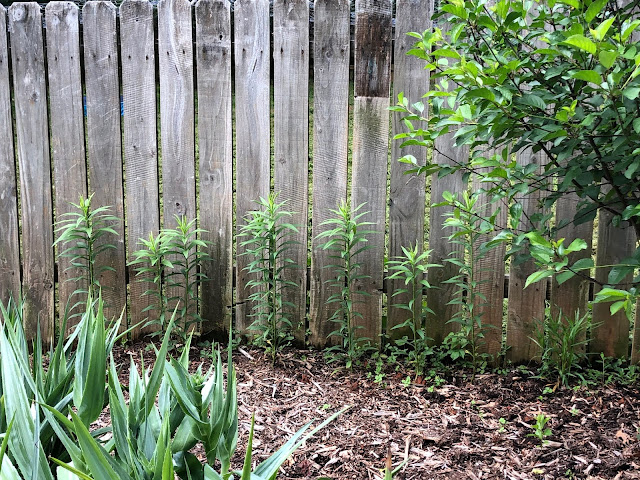These beauties are nestled in among the coneflowers and I also see three, make that four, spiky prickly weed thingies growing in there. They get tall and harder to pull so I need to get out there today and get them out. (Benefit of taking photo from above is you can see weeds easier!)
These are just starting to pop and this spot will be a mass of blooms soon. The asters tend to be long-blooming plants. I think this one is a bit early and partly why I didn’t remember what it was!
We’ve had a busy weekend on the farm, with lots of fun sightings of the critters we live with here.
My husband got a good photo of this black snake - I’ve seen one near Delphine, he saw one near the barn, now this one. Could be it’s the same snake, or could be more than one. Either way, I’m more than happy to share the outdoors with them. They help with mice and I think they’re beautiful. Plus, they lived here first.
Here’s a video of the milkweed yesterday afternoon. It’s a busy buffet for native bees.
I’m not seeing the honeybee girls up in the pollinator beds yet. They have so much blooming in Poplar Folly and Arcadia I think they’re working that area for now. As we move into summer the pollinator beds near the house will get busier, and lucky for the bees, honey and native, I have planted many things for them that bloom on through the season.
Here are a few more photos of interesting garden finds this weekend.
This is what the baptisia do after they finish blooming. I love this feature in the garden and it’s food for wildlife as well.
Here are a couple of photos showing the goldenrod plants I moved early on. A few of them wilted totally after transplant but they have all recovered nicely with some pampering. I didn’t quite finish the fenceline because it got hotter and I felt they would not make it. I’ll finish it off in the fall, when they can use the winter to grow their root systems without all the watering I’ve had to do with these.
And finally, more info on the Stokes’ aster:
Stokes’ aster ‘Peachie’s Pick’
Stokesia laevis ‘Peachie’s Pick’ (Stokes’ aster ‘Peachie’s Pick’). While this specific cultivar is of horticultural origin, Stokesia laevis is a native North American wildflower. It is also a member of the Asteraceae family.
The genus name honors Dr. Jonathan Stokes, a 18-19th century English physician. The cultivar name pays homage to the woman from Mississippi who discovered the plant, Peachie Saxton.
Stokesia laevis grows up to 45.72 cm (1.5 ft) tall with a 45.72 cm (1.5 ft) spread. Plants grow best in full sun with well-drained, sandy soil, but Stokesia laevis can also tolerate filtered sunlight and drought. The main killer of ‘Peachie’s Pick’ is wet soil in the winter, so it is very important to keep it well drained. It may also be helpful to use a layer of mulch in winter to protect against the cold.
This Stokes’ aster cultivar is best planted in small groupings throughout USDA Zones 5-9. The flowering stems tend to flop less than other Stokes’ asters, but their tall height leaves them susceptible to some reclining, especially after a strong thunderstorm. Stokesia laevis is a compact growing aster with fluffy, cornflower-like flowers (up to 7.62 cm across) colored lavender-blue. Especially if deadheaded, ‘Peachie’s Pick’ can bloom from midsummer to early fall. The stems originate from a rosette of oblong-lanceolate medium green leaves (up to 20.32 cm long). Stokesia also invites butterflies and bees to the garden!
| Botanical Name | Stokesia laevis ‘Peachie’s Pick’ |
| Common Name | Stokes’ aster ‘Peachie’s Pick’ |
| Family | Asteraceae |
| USDA Zone | 5 thru 9 |
| Light Requirement | Full Sun |
| Season(s) of interest | summer, fall, winter |
| Height and Spread | 1-1.5ft x 1-1.5ft (30-45cm x 30-45cm) |
| Flower Color | Blue, Purple |
| Attracts Wildlife | Hosts Caterpillars of Butterflies/Moths, Attracts Pollinators, Rarely Browsed by Mammalian Herbivores |
| Additional Information | Not Native to the US Midwest. S. laevisnative to southeastern North America. |
| Location in Lurie Garden | North Dark Plate, Northwest Light Plate |
















